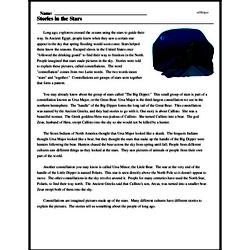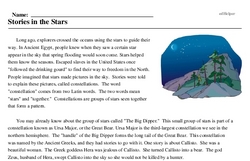Stories in the Stars
Long ago, explorers crossed the oceans using the stars to guide their way. In Ancient Egypt, people knew when they saw a certain star appear in the sky that spring flooding would soon come. Stars helped them know the seasons. Escaped slaves in the United States once "followed the drinking gourd" to find their way to freedom in the North. People imagined that stars made pictures in the sky. Stories were told to explain these pictures, called constellations. The word "constellation" comes from two Latin words. The two words mean "stars" and "together." Constellations are groups of stars seen together that form a pattern.
You may already know about the group of stars called "The Big Dipper." This small group of stars is part of a constellation known as Ursa Major, or the Great Bear. Ursa Major is the third-largest constellation we see in the northern hemisphere. The "handle" of the Big Dipper forms the long tail of the Great Bear. This constellation was named by the Ancient Greeks, and they had stories to go with it. One story is about Callisto. She was a beautiful woman. The Greek goddess Hera was jealous of Callisto. She turned Callisto into a bear. The god Zeus, husband of Hera, swept Callisto into the sky so she would not be killed by a hunter.
The Sioux Indians of North America thought that Ursa Major looked like a skunk. The Iroquois Indians thought Ursa Major looked like a bear, but they thought the stars that make up the handle of the Big Dipper were hunters following the bear. Hunters chased the bear across the sky from spring until fall. People from different cultures saw different things as they looked at the stars. They saw pictures of animals or people from their own part of the world.




